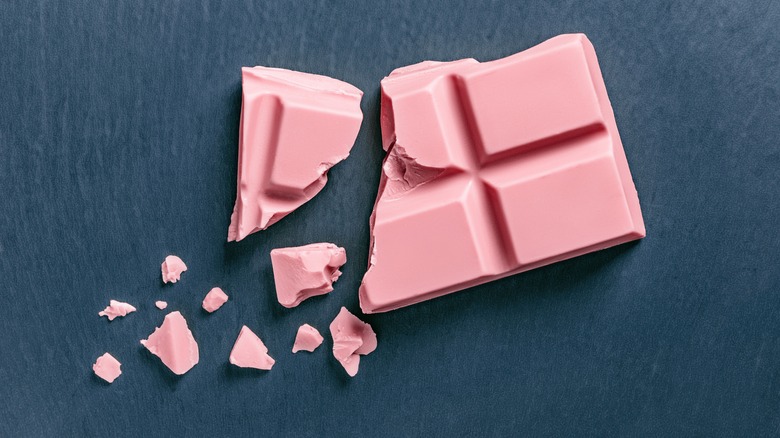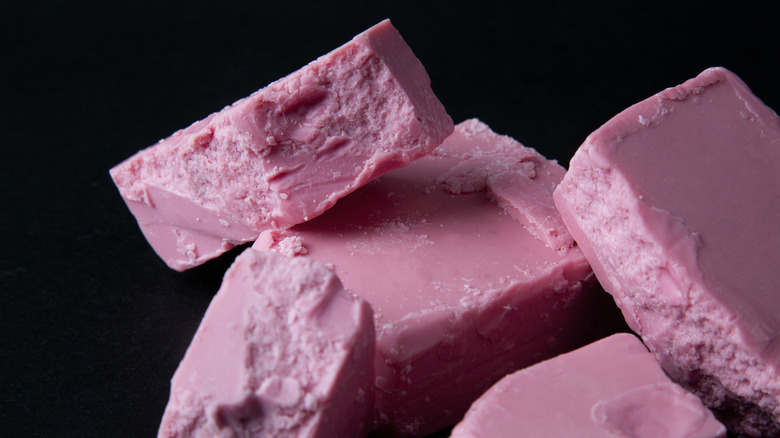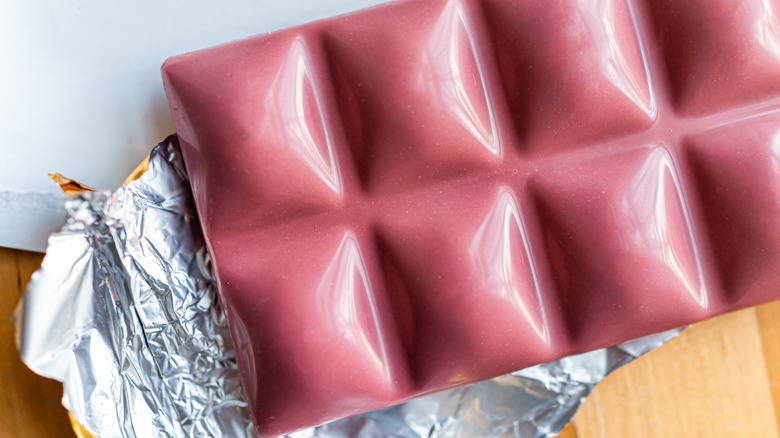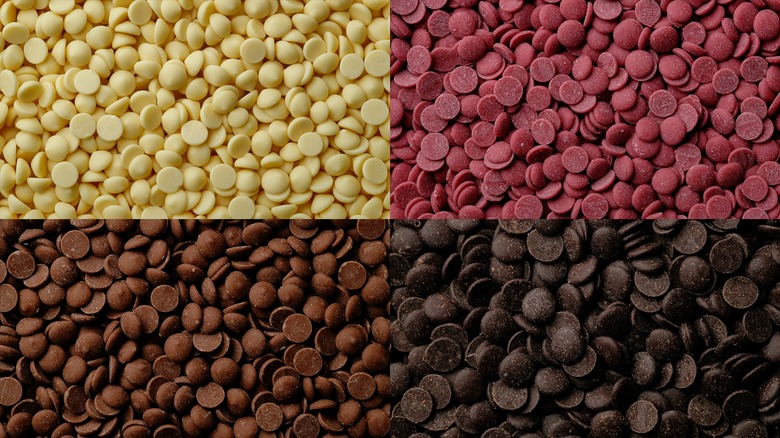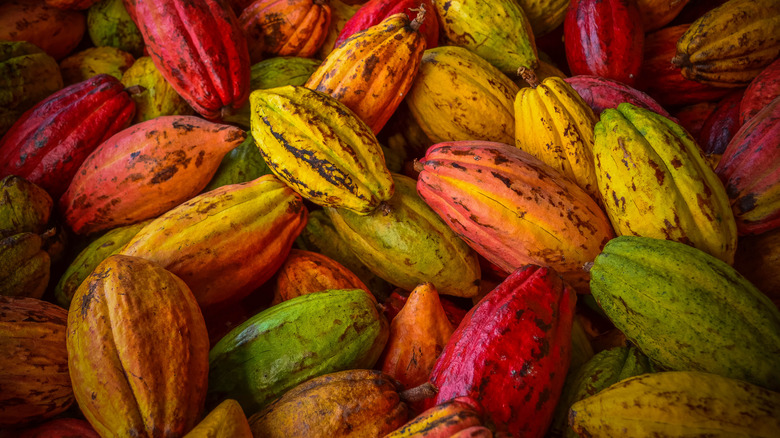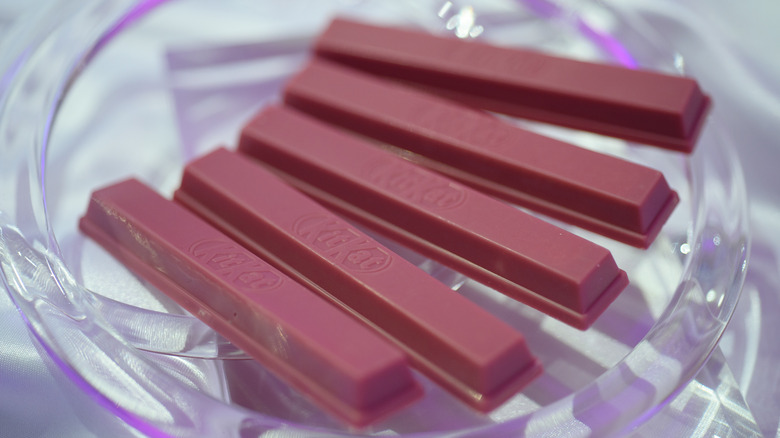What Exactly Is Ruby Chocolate And What Does It Taste Like?
On September 5, 2017, Swiss chocolate company Barry Callebaut stunned the culinary world by announcing it had created a fourth type of chocolate to join the ranks of dark, milk, and white. Dubbed "ruby chocolate," its dark pink hue made it an instant internet sensation, seemingly made for the Instagram era. Confectioners were both impressed and skeptical — this was the first new variety of chocolate to debut since Nestlé introduced white chocolate in its Milkybar (a.k.a. Galak) 80 years prior — and some questioned whether the new invention even counted as chocolate.
Ruby chocolate seemed tailor-made to its time and place in history. One of the biggest food trends of 2017 was "millennial pink," which saw a market saturated with rose-colored products intended to appeal to Generation Y. In a press release announcing its invention to the world, Barry Callebaut explained ruby chocolate's flavor as "berry-fruitiness and luscious smoothness." It also made the rather dramatic claim that ruby chocolate "satisfies a new consumer need found among Millennials — Hedonistic Indulgence." However, five years after ruby chocolate debuted, it's starting to look like it may go down as a fad.
As of 2023, ruby chocolate has come nowhere close to the popularity of dark, milk, and white chocolate. Only a select handful of chocolate brands have deals with Barry Callebaut to sell it. There have been legal battles over whether or not ruby chocolate can even be marketed as chocolate, complicating matters. Many chocolatiers have criticized it as a mere marketing stunt, and its controversial status seems unlikely to change anytime soon.
How is ruby chocolate made?
What makes ruby chocolate so controversial in the confectionary world is that Barry Callebaut has kept its manufacturing process secret. The few details it has released have raised eyebrows amongst other chocolatiers, with some questioning its veracity. Barry Callebaut claims that ruby chocolate is made from ruby cocoa beans sourced from Ecuador, Brazil, and Ivory Coast, which are responsible for its unique color and flavor. However, this is a bit misleading, as ruby cocoa beans are not actually a unique species of cocoa bean; it's just a term that Barry Callebaut uses to refer to beans that have undergone a particular type of fermentation and processing. Nobody outside of the company knows what these processes are.
Barry Callebaut's secrecy has ruffled feathers in the chocolate industry, particularly amongst small, bean-to-bar chocolatiers. There has been speculation that ruby cocoa beans may result from genetic modification, but representatives for Barry Callebaut have denied this. The company obtained a European Patent for "A process for producing red or purple cocoa-derived material" in 2009. This document describes a process whereby unfermented cocoa beans with high polyphenol levels are treated with an acid. Ingredients listed on ruby chocolate products always include citric acid, so we know this is part of the formula, but beyond that, little more is known.
What does ruby chocolate taste like?
Ruby chocolate tastes quite different from any other type of chocolate. It is sweeter than any of its predecessors, and strangely enough, it doesn't have any cocoa flavor despite being made principally from cocoa butter.
Instead, ruby chocolate has a distinctly fruity flavor. It is closely reminiscent of raspberries, and even though the taste is quite sweet overall, there is a hint of sourness present as well, which may be the result of the citric acid used in Barry Callebaut's proprietary manufacturing process. Many ruby chocolate products pair it with other fruity ingredients to accentuate this.
Texturally, ruby chocolate is smooth and creamy, akin to milk and white chocolate. Its light, fruity flavor makes it less rich than other types of chocolate, and from its very inception, there was speculation that ruby chocolate could lead people to buy and eat larger quantities than they would with other chocolates.
Is ruby chocolate really chocolate?
From the moment it debuted in 2017, a debate has raged over whether ruby chocolate deserved to be classified as a new type of chocolate. The great lengths Barry Callebaut has taken to keep its manufacturing process under wraps have fueled much of this skepticism.
This has been such a controversial subject, in fact, that when ruby chocolate first debuted, the United States government did not permit it to be sold under the name "chocolate." Instead, it was marketed as "ruby cacao" or "ruby couverture." It wasn't until 2021 that Barry Callebaut finally obtained a permit from the FDA to legally classify its product as chocolate.
It could be some time before ruby chocolate is widely accepted as a unique form of chocolate, and perhaps that day will never come. The question of whether white chocolate is actually chocolate has still not been resolved today, and it had an eight-decade head start over ruby chocolate.
There's an even more controversial side to ruby chocolate
The question of ruby chocolate and the secrecy surrounding its manufacturing processes are not the only factors that make it such a controversial product. Barry Callebaut has come under scrutiny in the past for its sourcing of cocoa beans. In a 2018 report, the company claimed that just 44% of its cocoa beans were sustainably sourced, though it set a goal to reach 100% sustainability by 2025.
Barry Callebaut has also pledged to eliminate child labor in its supply chain. Still, the fact that the company relied on child labor in the first place has been a significant point of criticism, coming under further scrutiny with the hype surrounding ruby chocolate's unveiling. Accusations of child slavery are a significant issue in the chocolate industry, with Barry Callebaut having been tied up in lawsuits multiple times over the issue.
Where can you get ruby chocolate?
Barry Callebaut is a business-to-business company, meaning it supplies ruby chocolate to other confectionery makers, and those companies are then free to turn it into their own products. Nestlé was the first company to secure a deal with Barry Callebaut to distribute ruby chocolate products, securing exclusive rights for six months. It proceeded to make a massive splash by unveiling ruby chocolate KitKats, first released in Japan at the beginning of 2018, but they were only a limited-edition item.
The leading purveyor of ruby chocolate products in the United States is Chocolove. It sells a plain ruby chocolate bar and passion fruit-filled ruby chocolate bar. You can purchase them both on the Chocolove website. The plain bars are sold in a 12-pack priced at $39, and the passion fruit bars are sold in 10-packs for $32.50. Barry Callebaut also sells ruby chocolate callets. Chocolate callets look like wide, flat chocolate chips and are meant to be melted and molded into different confections. You can buy them at some restaurant supply stores and online.
